Identifying Leadership Style Impact on Staff Retention: A Tesco Study
VerifiedAdded on 2020/09/03
|6
|1068
|44
Project
AI Summary
This research proposal investigates the impact of leadership style on staff retention, focusing on a case study at Tesco. The introduction outlines the research overview, significance, aim, objectives, questions, and potential issues. Chapter 2 provides a literature review on leadership and employee retention strategies. Chapter 3 details the research methodology, including the type of investigation (qualitative), research design (descriptive), philosophy (interpretivism), approach (inductive), data sampling, and collection methods (primary and secondary). Ethical considerations are also addressed. The study aims to identify effective leadership styles for retaining employees, analyze the relationship between leadership style and staff retention, and recommend strategies for Tesco's leaders to improve employee retention. The research employs qualitative methods, including simple random sampling and data collection through primary and secondary sources. The proposal includes a detailed table of contents and a list of references. The study emphasizes the importance of leadership in fostering employee satisfaction and reducing turnover.
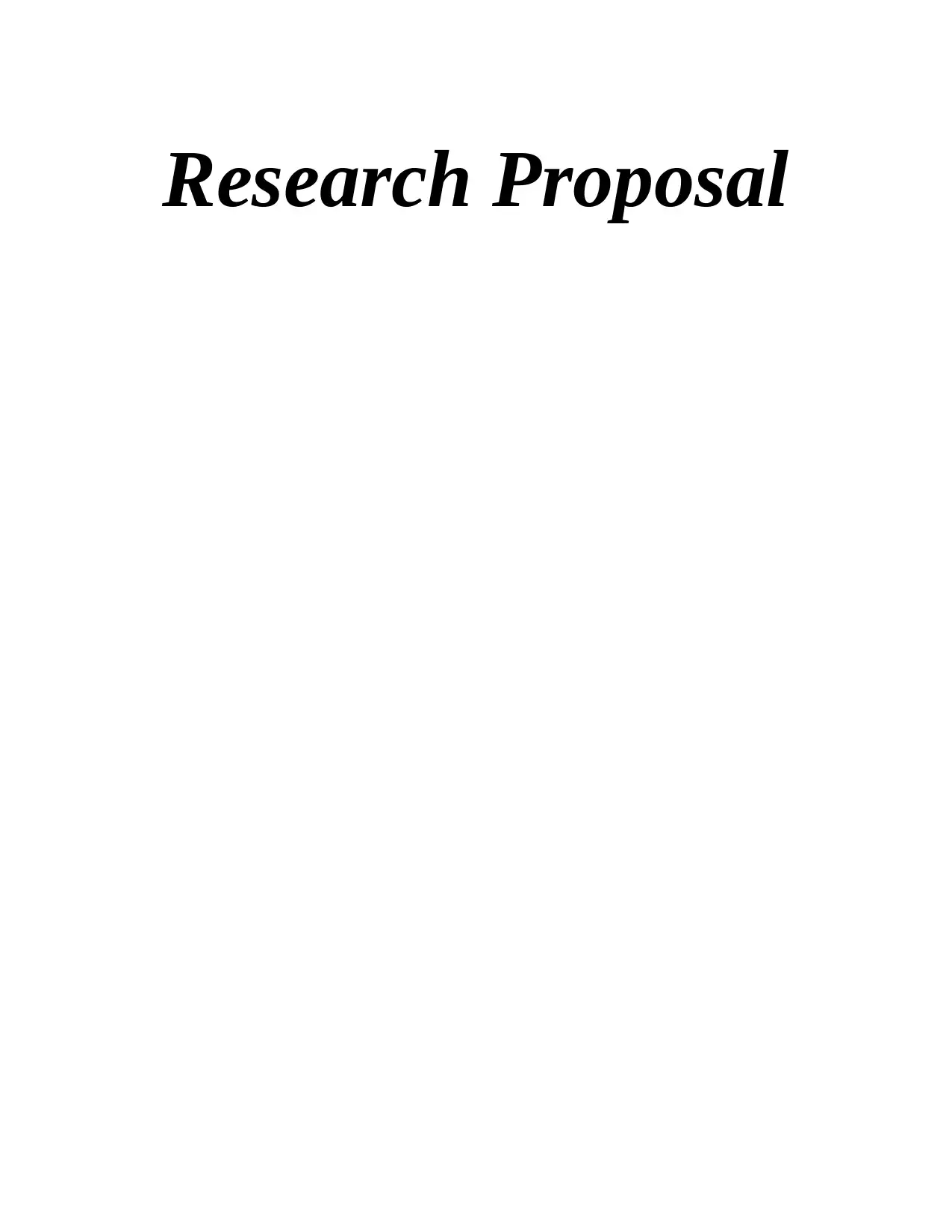
Research Proposal
Paraphrase This Document
Need a fresh take? Get an instant paraphrase of this document with our AI Paraphraser
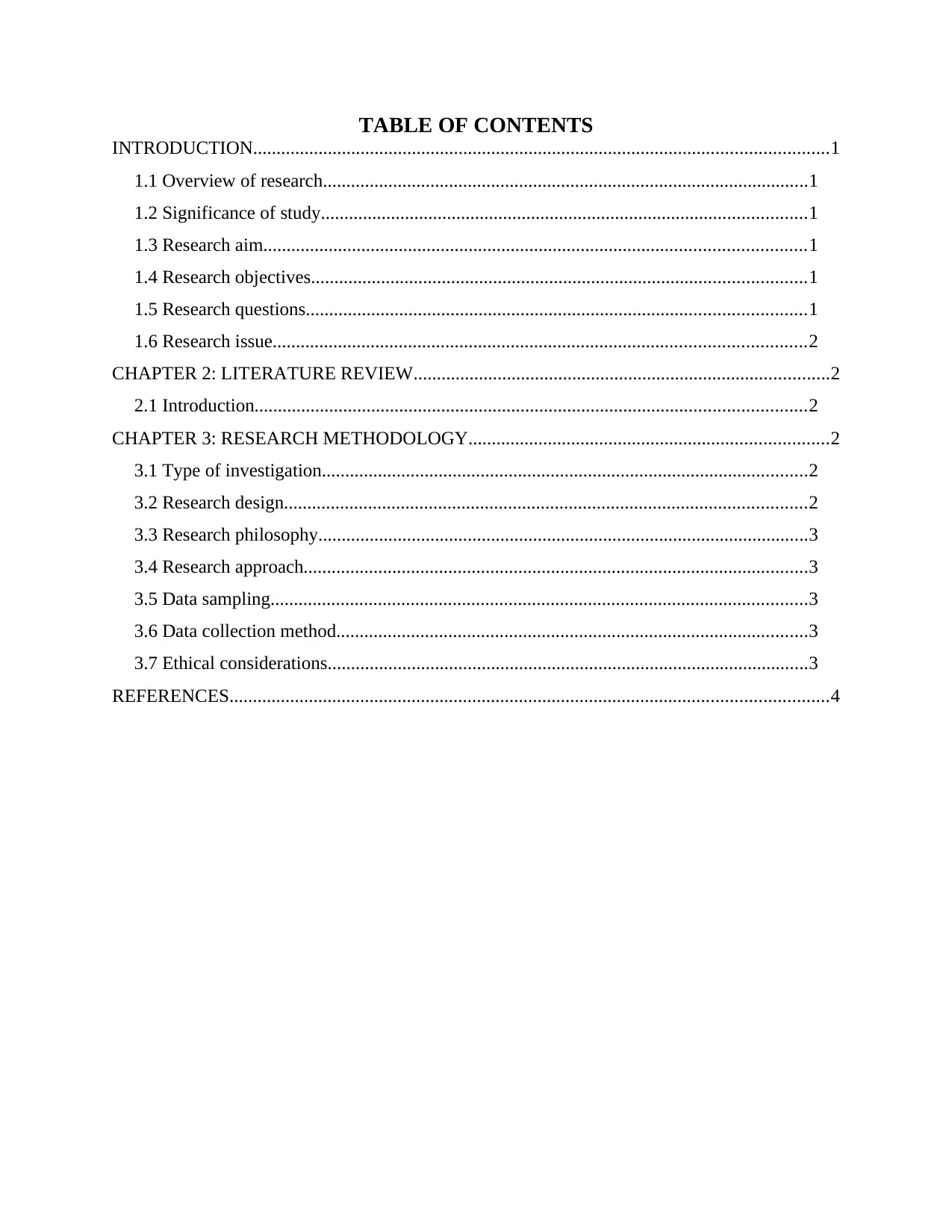
TABLE OF CONTENTS
INTRODUCTION...........................................................................................................................1
1.1 Overview of research........................................................................................................1
1.2 Significance of study........................................................................................................1
1.3 Research aim....................................................................................................................1
1.4 Research objectives..........................................................................................................1
1.5 Research questions...........................................................................................................1
1.6 Research issue..................................................................................................................2
CHAPTER 2: LITERATURE REVIEW.........................................................................................2
2.1 Introduction......................................................................................................................2
CHAPTER 3: RESEARCH METHODOLOGY.............................................................................2
3.1 Type of investigation........................................................................................................2
3.2 Research design................................................................................................................2
3.3 Research philosophy.........................................................................................................3
3.4 Research approach............................................................................................................3
3.5 Data sampling...................................................................................................................3
3.6 Data collection method.....................................................................................................3
3.7 Ethical considerations.......................................................................................................3
REFERENCES................................................................................................................................4
INTRODUCTION...........................................................................................................................1
1.1 Overview of research........................................................................................................1
1.2 Significance of study........................................................................................................1
1.3 Research aim....................................................................................................................1
1.4 Research objectives..........................................................................................................1
1.5 Research questions...........................................................................................................1
1.6 Research issue..................................................................................................................2
CHAPTER 2: LITERATURE REVIEW.........................................................................................2
2.1 Introduction......................................................................................................................2
CHAPTER 3: RESEARCH METHODOLOGY.............................................................................2
3.1 Type of investigation........................................................................................................2
3.2 Research design................................................................................................................2
3.3 Research philosophy.........................................................................................................3
3.4 Research approach............................................................................................................3
3.5 Data sampling...................................................................................................................3
3.6 Data collection method.....................................................................................................3
3.7 Ethical considerations.......................................................................................................3
REFERENCES................................................................................................................................4
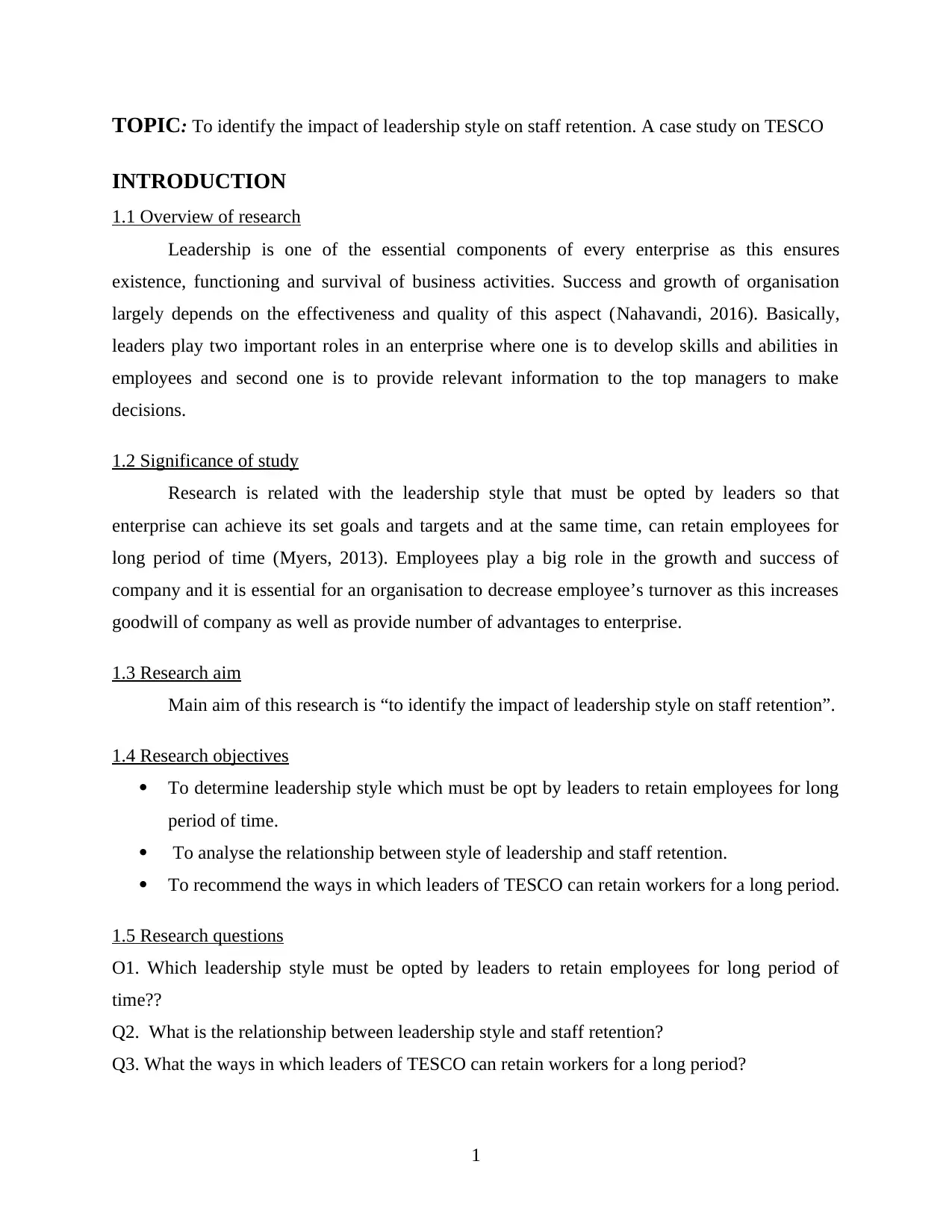
TOPIC: To identify the impact of leadership style on staff retention. A case study on TESCO
INTRODUCTION
1.1 Overview of research
Leadership is one of the essential components of every enterprise as this ensures
existence, functioning and survival of business activities. Success and growth of organisation
largely depends on the effectiveness and quality of this aspect (Nahavandi, 2016). Basically,
leaders play two important roles in an enterprise where one is to develop skills and abilities in
employees and second one is to provide relevant information to the top managers to make
decisions.
1.2 Significance of study
Research is related with the leadership style that must be opted by leaders so that
enterprise can achieve its set goals and targets and at the same time, can retain employees for
long period of time (Myers, 2013). Employees play a big role in the growth and success of
company and it is essential for an organisation to decrease employee’s turnover as this increases
goodwill of company as well as provide number of advantages to enterprise.
1.3 Research aim
Main aim of this research is “to identify the impact of leadership style on staff retention”.
1.4 Research objectives
To determine leadership style which must be opt by leaders to retain employees for long
period of time.
To analyse the relationship between style of leadership and staff retention.
To recommend the ways in which leaders of TESCO can retain workers for a long period.
1.5 Research questions
O1. Which leadership style must be opted by leaders to retain employees for long period of
time??
Q2. What is the relationship between leadership style and staff retention?
Q3. What the ways in which leaders of TESCO can retain workers for a long period?
1
INTRODUCTION
1.1 Overview of research
Leadership is one of the essential components of every enterprise as this ensures
existence, functioning and survival of business activities. Success and growth of organisation
largely depends on the effectiveness and quality of this aspect (Nahavandi, 2016). Basically,
leaders play two important roles in an enterprise where one is to develop skills and abilities in
employees and second one is to provide relevant information to the top managers to make
decisions.
1.2 Significance of study
Research is related with the leadership style that must be opted by leaders so that
enterprise can achieve its set goals and targets and at the same time, can retain employees for
long period of time (Myers, 2013). Employees play a big role in the growth and success of
company and it is essential for an organisation to decrease employee’s turnover as this increases
goodwill of company as well as provide number of advantages to enterprise.
1.3 Research aim
Main aim of this research is “to identify the impact of leadership style on staff retention”.
1.4 Research objectives
To determine leadership style which must be opt by leaders to retain employees for long
period of time.
To analyse the relationship between style of leadership and staff retention.
To recommend the ways in which leaders of TESCO can retain workers for a long period.
1.5 Research questions
O1. Which leadership style must be opted by leaders to retain employees for long period of
time??
Q2. What is the relationship between leadership style and staff retention?
Q3. What the ways in which leaders of TESCO can retain workers for a long period?
1
⊘ This is a preview!⊘
Do you want full access?
Subscribe today to unlock all pages.

Trusted by 1+ million students worldwide
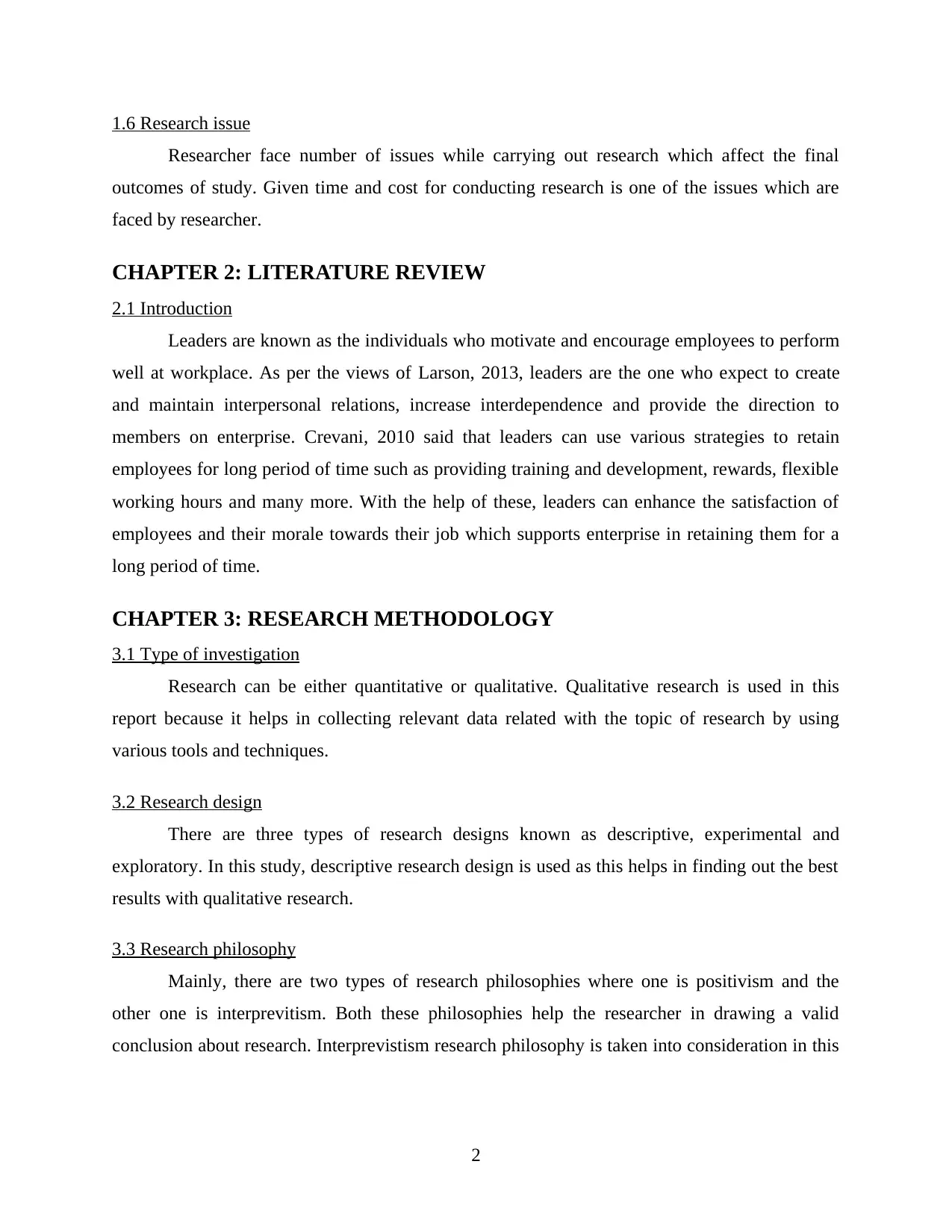
1.6 Research issue
Researcher face number of issues while carrying out research which affect the final
outcomes of study. Given time and cost for conducting research is one of the issues which are
faced by researcher.
CHAPTER 2: LITERATURE REVIEW
2.1 Introduction
Leaders are known as the individuals who motivate and encourage employees to perform
well at workplace. As per the views of Larson, 2013, leaders are the one who expect to create
and maintain interpersonal relations, increase interdependence and provide the direction to
members on enterprise. Crevani, 2010 said that leaders can use various strategies to retain
employees for long period of time such as providing training and development, rewards, flexible
working hours and many more. With the help of these, leaders can enhance the satisfaction of
employees and their morale towards their job which supports enterprise in retaining them for a
long period of time.
CHAPTER 3: RESEARCH METHODOLOGY
3.1 Type of investigation
Research can be either quantitative or qualitative. Qualitative research is used in this
report because it helps in collecting relevant data related with the topic of research by using
various tools and techniques.
3.2 Research design
There are three types of research designs known as descriptive, experimental and
exploratory. In this study, descriptive research design is used as this helps in finding out the best
results with qualitative research.
3.3 Research philosophy
Mainly, there are two types of research philosophies where one is positivism and the
other one is interprevitism. Both these philosophies help the researcher in drawing a valid
conclusion about research. Interprevistism research philosophy is taken into consideration in this
2
Researcher face number of issues while carrying out research which affect the final
outcomes of study. Given time and cost for conducting research is one of the issues which are
faced by researcher.
CHAPTER 2: LITERATURE REVIEW
2.1 Introduction
Leaders are known as the individuals who motivate and encourage employees to perform
well at workplace. As per the views of Larson, 2013, leaders are the one who expect to create
and maintain interpersonal relations, increase interdependence and provide the direction to
members on enterprise. Crevani, 2010 said that leaders can use various strategies to retain
employees for long period of time such as providing training and development, rewards, flexible
working hours and many more. With the help of these, leaders can enhance the satisfaction of
employees and their morale towards their job which supports enterprise in retaining them for a
long period of time.
CHAPTER 3: RESEARCH METHODOLOGY
3.1 Type of investigation
Research can be either quantitative or qualitative. Qualitative research is used in this
report because it helps in collecting relevant data related with the topic of research by using
various tools and techniques.
3.2 Research design
There are three types of research designs known as descriptive, experimental and
exploratory. In this study, descriptive research design is used as this helps in finding out the best
results with qualitative research.
3.3 Research philosophy
Mainly, there are two types of research philosophies where one is positivism and the
other one is interprevitism. Both these philosophies help the researcher in drawing a valid
conclusion about research. Interprevistism research philosophy is taken into consideration in this
2
Paraphrase This Document
Need a fresh take? Get an instant paraphrase of this document with our AI Paraphraser
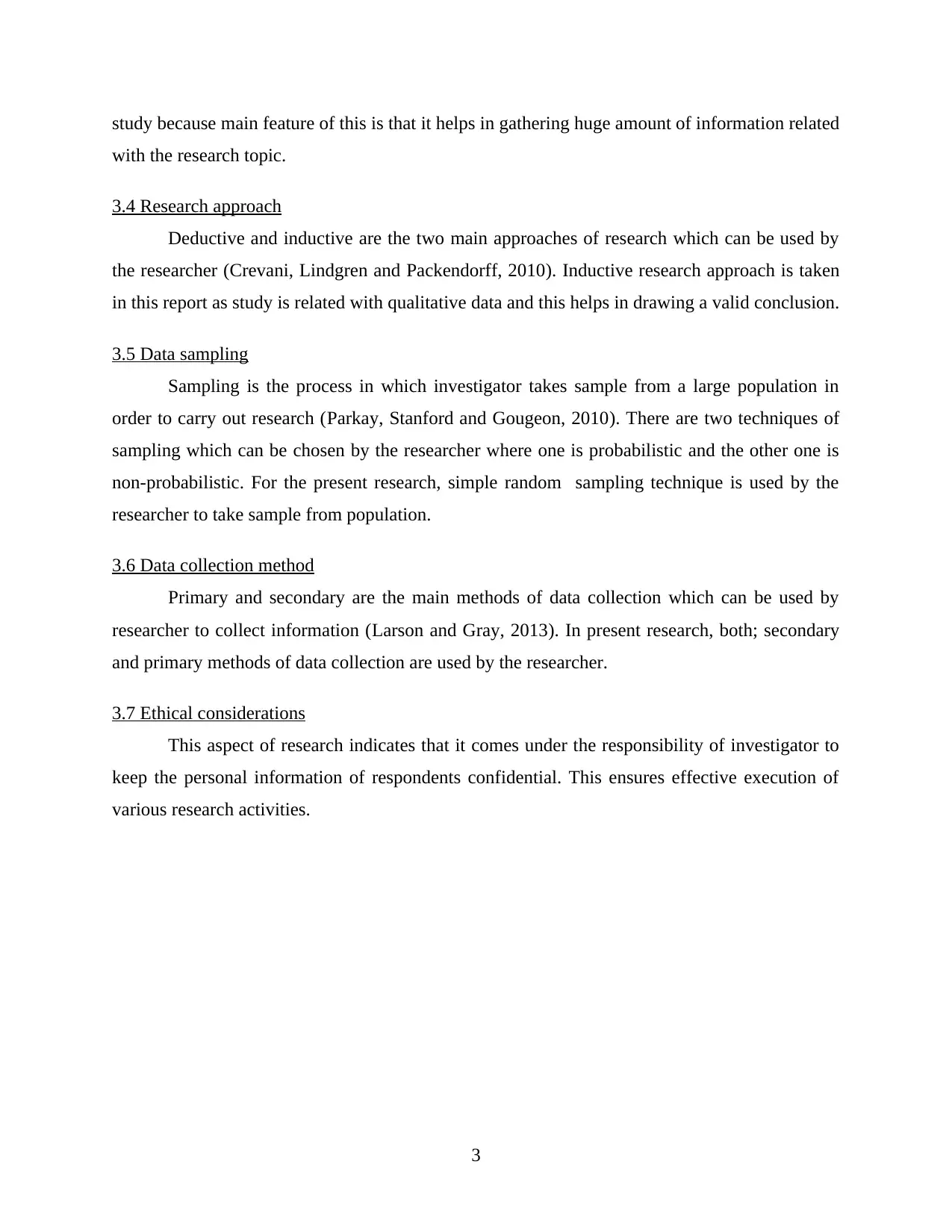
study because main feature of this is that it helps in gathering huge amount of information related
with the research topic.
3.4 Research approach
Deductive and inductive are the two main approaches of research which can be used by
the researcher (Crevani, Lindgren and Packendorff, 2010). Inductive research approach is taken
in this report as study is related with qualitative data and this helps in drawing a valid conclusion.
3.5 Data sampling
Sampling is the process in which investigator takes sample from a large population in
order to carry out research (Parkay, Stanford and Gougeon, 2010). There are two techniques of
sampling which can be chosen by the researcher where one is probabilistic and the other one is
non-probabilistic. For the present research, simple random sampling technique is used by the
researcher to take sample from population.
3.6 Data collection method
Primary and secondary are the main methods of data collection which can be used by
researcher to collect information (Larson and Gray, 2013). In present research, both; secondary
and primary methods of data collection are used by the researcher.
3.7 Ethical considerations
This aspect of research indicates that it comes under the responsibility of investigator to
keep the personal information of respondents confidential. This ensures effective execution of
various research activities.
3
with the research topic.
3.4 Research approach
Deductive and inductive are the two main approaches of research which can be used by
the researcher (Crevani, Lindgren and Packendorff, 2010). Inductive research approach is taken
in this report as study is related with qualitative data and this helps in drawing a valid conclusion.
3.5 Data sampling
Sampling is the process in which investigator takes sample from a large population in
order to carry out research (Parkay, Stanford and Gougeon, 2010). There are two techniques of
sampling which can be chosen by the researcher where one is probabilistic and the other one is
non-probabilistic. For the present research, simple random sampling technique is used by the
researcher to take sample from population.
3.6 Data collection method
Primary and secondary are the main methods of data collection which can be used by
researcher to collect information (Larson and Gray, 2013). In present research, both; secondary
and primary methods of data collection are used by the researcher.
3.7 Ethical considerations
This aspect of research indicates that it comes under the responsibility of investigator to
keep the personal information of respondents confidential. This ensures effective execution of
various research activities.
3
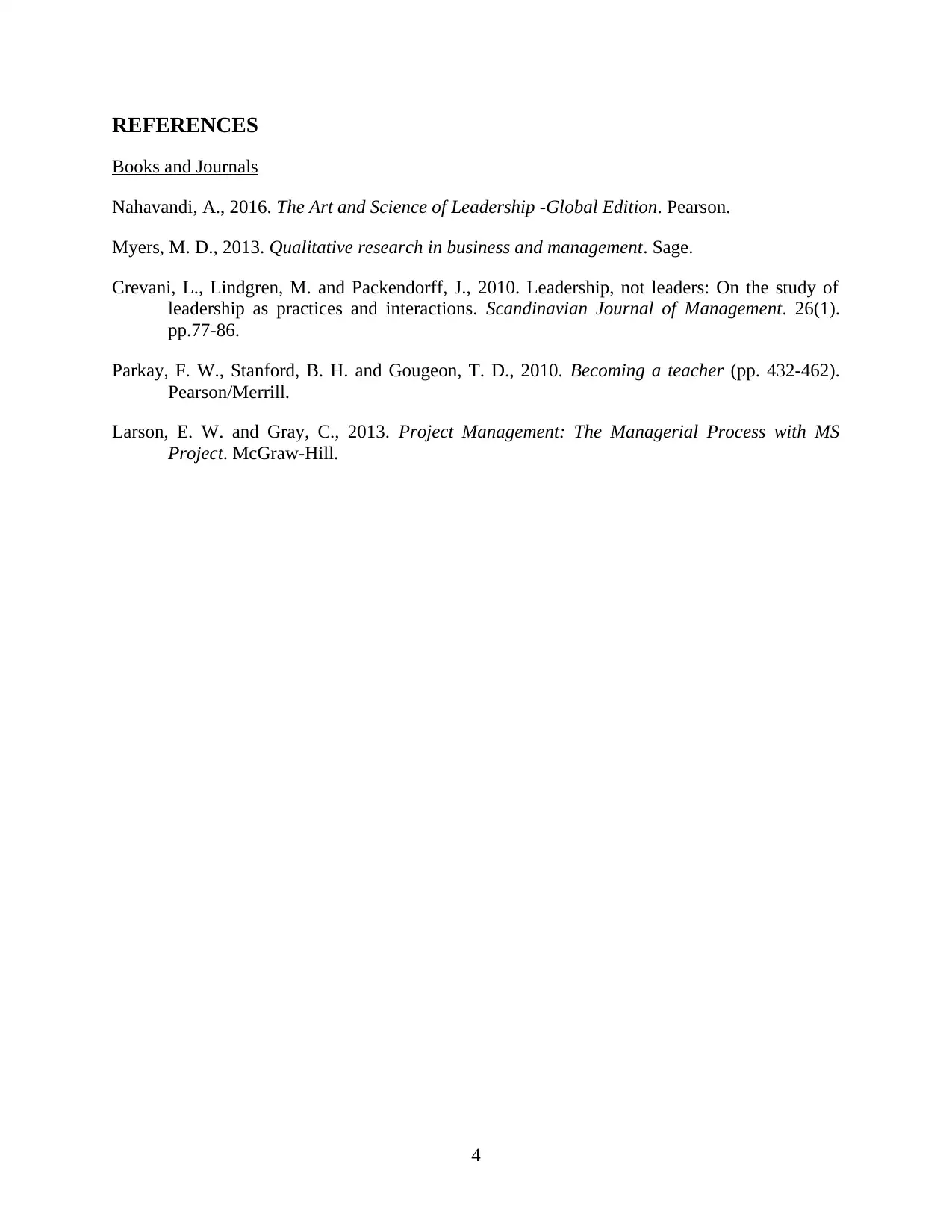
REFERENCES
Books and Journals
Nahavandi, A., 2016. The Art and Science of Leadership -Global Edition. Pearson.
Myers, M. D., 2013. Qualitative research in business and management. Sage.
Crevani, L., Lindgren, M. and Packendorff, J., 2010. Leadership, not leaders: On the study of
leadership as practices and interactions. Scandinavian Journal of Management. 26(1).
pp.77-86.
Parkay, F. W., Stanford, B. H. and Gougeon, T. D., 2010. Becoming a teacher (pp. 432-462).
Pearson/Merrill.
Larson, E. W. and Gray, C., 2013. Project Management: The Managerial Process with MS
Project. McGraw-Hill.
4
Books and Journals
Nahavandi, A., 2016. The Art and Science of Leadership -Global Edition. Pearson.
Myers, M. D., 2013. Qualitative research in business and management. Sage.
Crevani, L., Lindgren, M. and Packendorff, J., 2010. Leadership, not leaders: On the study of
leadership as practices and interactions. Scandinavian Journal of Management. 26(1).
pp.77-86.
Parkay, F. W., Stanford, B. H. and Gougeon, T. D., 2010. Becoming a teacher (pp. 432-462).
Pearson/Merrill.
Larson, E. W. and Gray, C., 2013. Project Management: The Managerial Process with MS
Project. McGraw-Hill.
4
⊘ This is a preview!⊘
Do you want full access?
Subscribe today to unlock all pages.

Trusted by 1+ million students worldwide
1 out of 6
Related Documents
Your All-in-One AI-Powered Toolkit for Academic Success.
+13062052269
info@desklib.com
Available 24*7 on WhatsApp / Email
![[object Object]](/_next/static/media/star-bottom.7253800d.svg)
Unlock your academic potential
Copyright © 2020–2025 A2Z Services. All Rights Reserved. Developed and managed by ZUCOL.





